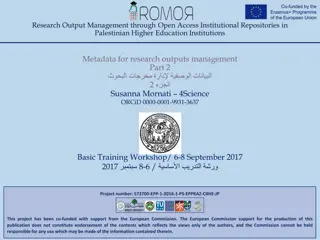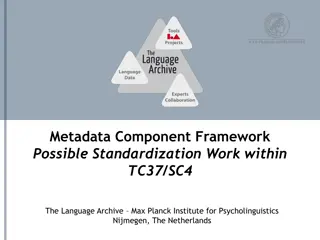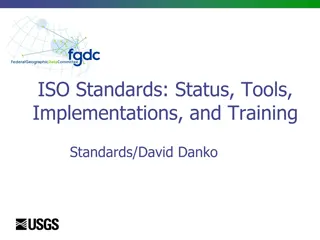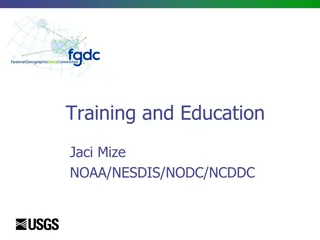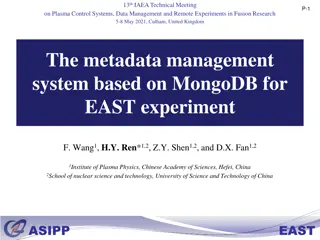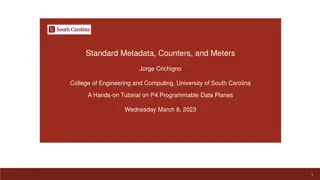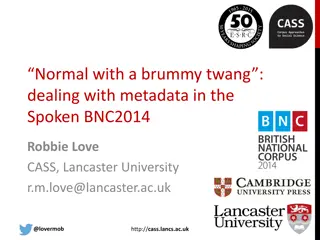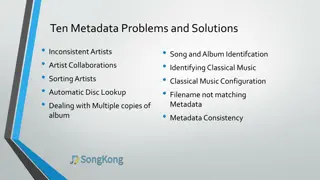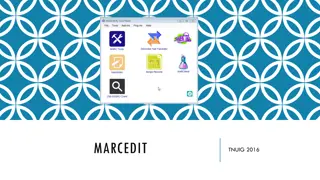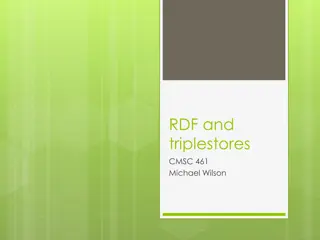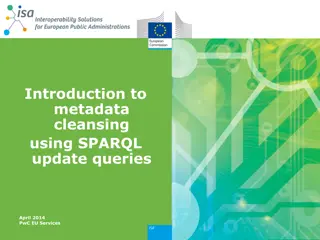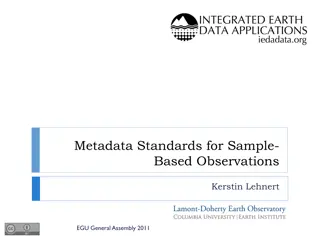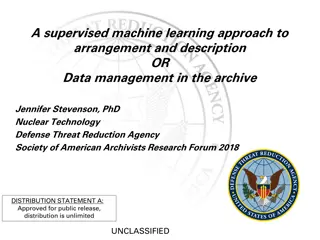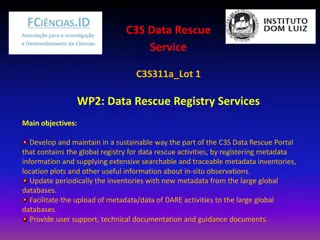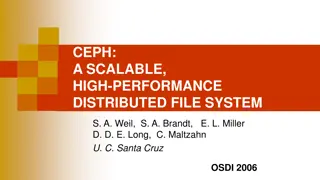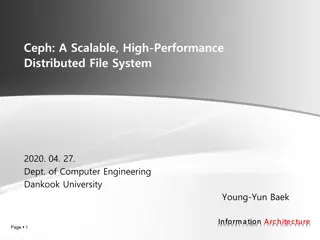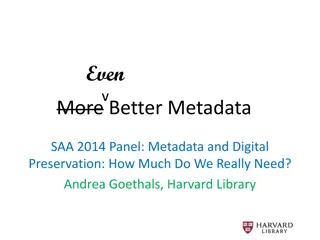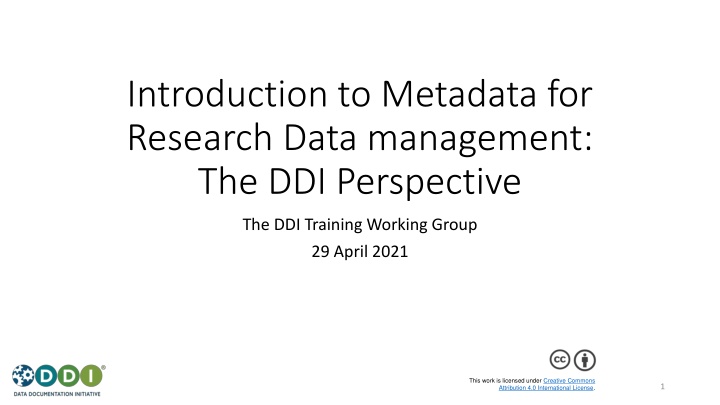
Importance of Metadata in Research Data Management
Metadata is crucial for data management as it enables discovery, assessment, and navigation through collections of data. It allows people to understand, process, and manage data effectively. Good metadata is key to ensuring quality data and successful research outcomes, especially in large, cross-cutting projects.
Download Presentation

Please find below an Image/Link to download the presentation.
The content on the website is provided AS IS for your information and personal use only. It may not be sold, licensed, or shared on other websites without obtaining consent from the author. If you encounter any issues during the download, it is possible that the publisher has removed the file from their server.
You are allowed to download the files provided on this website for personal or commercial use, subject to the condition that they are used lawfully. All files are the property of their respective owners.
The content on the website is provided AS IS for your information and personal use only. It may not be sold, licensed, or shared on other websites without obtaining consent from the author.
E N D
Presentation Transcript
Introduction to Metadata for Research Data management: The DDI Perspective The DDI Training Working Group 29 April 2021 This work is licensed under Creative Commons Attribution 4.0 International License. 1
Some Obvious Questions Why should we care so much about metadata? Isn t it just data about data ? Shouldn t we be focused on the data? 2
If You Care about Data, You Care about Metadata! Metadata is what allows people to discover, assess, and navigate through collections of data Metadata is what allows people to understand data Metadata is what allows machines to process and manage data Metadata is what allows people to harmonize, integrate, and reuse data If you want FAIR data, you need metadata! 3
Metadata is the Limiting Factor Your data is only as good as the metadata which describes it Traditionally, research has focused on data supporting specific research Now, the demand for larger, cross-cutting research projects places an emphasis on better data management The answer to providing this is to have good, well-managed metadata! 4
Different Understandings and Definitions Across research domains, the term metadata means many different things We need to respect these differences We also need a shared understanding The DDI community has spent decades understanding metadata, using it to manage data, and modelling it for implementation in systems We do not have the only perspective but we do have a proven, useful one! 5
Contents Defining Metadata Data or Metadata? Examples Roles Usage Management Summary 7
What is in this can? What is in this can?
Now you know! Now you know!
What do the numbers in this table mean? What do the numbers in this table mean?
Metadata tells us! Metadata tells us! Metadata
What Does Meta Mean, Anyway? Metadata are descriptions or information about some thing(s) Greek: - is a prefix meaning Beyond After Transcending Literally metadata are beyond the thing(s) being described
Metadata Clarification The numeric table Metadata are Headings for the columns Descriptions of the values in each column They describe the table and the data in the cells People define it as data about data , but The food can Metadata are what is written in the label on the can They describe the contents of the can Let s look at this in more detail
Metadata Defined Metadata Defined Not Just Not Just Data about Data Data about Data Metadata may be about data Numeric table example Metadata may be about some other things Food can example Requires broad view of metadata Data about some resource Enhanced definition Metadata <-> data intended to be used for describing some object(s) 15
Metadata or Data? It Depends! Question How do we intend to use the data? Microdata data used to represent a population Not each individual respondent, but for producing statistics Administrative data data used to manage a social program Data used to monitor eligibility and results Primary purpose of data is not to describe Metadata are intended to describe Data are intended to measure 17
Metadata versus Data Consider microdata or administrative data Microdata data collected from respondents in a statistical survey collected data are a description of each respondent Administrative data data acquired as a result of managing some social program managed data are a description of each program participant Why aren t these metadata? In each case, data describe some things, but Survey responses are used to measure characteristics of a population Administrative data are used to measure characteristics of the program participants 18
Metadata A Role Metadata is a role for data No data are always metadata Data are metadata when they are used that way Most (if not all) data can be used as metadata Sometimes, data could be both metadata and data Depends on usage Same data, different perspective 19
Examples 20
Dublin Core Metadata Example Dublin Core Commonly used metadata standard Dublin Core Metadata Element Set Originally 15 core elements Over 40 additional elements Developed by Online Computer Library Center Dublin, OH Used in many digital libraries Museums, Book libraries Objects of interest: Museums paintings, bones, pictures, documents, tools not data Book libraries books and magazines 21
Telephone Call Example (1) Another example telephone company data Telephone company knows Who called whom Whether connection is made or why it failed Length of connection But they don t have the content of each conversation Telephone data contains: One number was used to call another Including subscriber information of caller Date/time this occurred Whether a connection was made How long connection lasted 22
Telephone Call Example (2) Use as data Build network of calls Nodes are phone number / subscribers Use as metadata Part of the description of a particular phone call The role the data play is crucial for making the distinction 23
Classification Scheme Example Classification scheme entry Concept, code, definition, description, relationships Data for a classification database Data for construction of n-cubes, as element of a dimension Data for construction of stratified sample Metadata for user of a table as description (meaning) of a cell Metadata for user of data based on the stratified sample 24
Roles 25
Roles of Metadata Metadata supports 3 main uses: Discovery - find relevant resources (e.g., data) Understandability - convey the semantics of resources Usage - describe limits of reasonable use Above uses are roles Variables apply in all three cases So do data sets Therefore, structures of data do as well But these are definitely not the only roles 26
Usage 27
What Do We Want to Describe? Metadata may be used to describe Data Variables Segments Value Domains Classification schemes Code lists Questions Questionnaires Instruments Collection process Sample design Weighting Data transformations Editing procedures Machine Learning methods Allocation Estimation Disclosure control 28
Uses of Metadata - Simple Document descriptions of statistical objects Promote records management Provide means of comparison across Objects (e.g., classification schemes) Programs, experiments, studies Time Organizations Subject areas (including within broad domains) Cultures (especially languages) Political entities (e.g., countries) 29
Uses of Metadata - Enhanced Create new descriptions of more complex objects Descriptions of variables used to describe each data set Descriptions of questions used to describe question form or questionnaire Promote reuse describe once, use many Increase comparability Reduce inconsistency Avoid gratuitous differences Increase quality Reduce future burden Reduce costs 30
Uses of Metadata - Advanced Promote machine-readable metadata Avoid using long prose documents Implement machine-readable formats (e.g., XML, JSON) Strive towards metadata-driven processing Machine-actionable metadata Promote concept management Note how and where concepts are used E.g., Concept, Universe, Category, Variable Link similar meanings For definitions, use principles defined in ISO 704 (Terminology Principles and methods) ISO/IEC 11179-4 (Information technology Metadata registries (MDR) Part 4: Formulation of data definitions) For terminological approach to data and metadata, based on ISO 704 31
Management 32
Managing Metadata Metadata are data Metadata can be managed in a database A metadata repository is a database of metadata Metadata is also often stored in data repositories Relational, Object-oriented, Graph / Network, Other? Depends on several factors Available software Current expertise Integration with other systems Time frame Costs Risks 33
Benefits of Managed Metadata More consistency in the production and dissemination of data More comparable data More understandable data More FAIR data Assessing and ensuring data quality Organizational efficiency Reuse of metadata assets Better design, implementation, and execution of processes Increased automation 34
Summary Definition of metadata data intended to be used for describing some object(s) Compare with data When are data metadata? It depends. Roles Metadata can be used for multiple purposes (administrative, semantic, etc.) Uses Human readable documentation Sharing metadata and reusable descriptions Concept management and machine-readable metadata Management Metadata are data, so they may be managed similarly 35
DDI Metadata Evolution DDI has been producing specifications for metadata in RDM for more than 2 decades Our understanding of metadata has evolved Our suite of products has grown to support more aspects of RDM The evolution is ongoing 37
DDI: Major Specifications DDI Codebook (aka DDI 1.0 , DDI 1.2 , DDI 2.5 , etc.) DDI Lifecycle (aka DDI 3.0 , DDI 3.1 , DDI 3.3 , etc.) DDI Cross Domain Integration (aka DDI-CDI ) 38
DDI Codebook An XML description of a codebook (a data dictionary) Rectangular files No concept of metadata reuse Based on models in existing analysis tools (Stata, SPSS, SAS, etc.) Included Dublin Core and descriptive study-level metadata Machine-readable (slightly machine-actionable ) Described data for a single study (one point in time) After-the-fact description to support archiving and reuse 39
DDI Lifecycle Major expansion Describe multiple waves for longitudinal/repeat data collection Describe comparison and harmonization Describe data collection and survey instruments Describe the entire data lifecycle Reuse of metadata was central to these functions Support for centralized metadata management Focus still primarily on rectangular data XML encoding Machine-readable Machine-actionable 40
An Important Change DDI Codebook allowed you to reference Concepts from variable descriptions DDI Lifecycle provided full-blown support for describing Concepts and reusing them Referenced by Variables Referenced by Categories in Classifications/Codelists Referenced by Units/Populations/Universes With the popular semantic technologies, Concepts become central SKOS is the most-used vocabulary in the RDF world Basis of sematic mapping between organizations/domains 42
DDI Cross-Domain Integration (DDI-CDI) An extension of the metadata set found in DDI-C and DDI-L Not a replacement! Will be released Summer 2021 Provides support for additional types of data Long data/sensor data/event data Multi-dimensional data/data cubes Key-Value data/No SQL data/ big data Provides support for describing process and provenance across data sets as data is reused/harmonized/integrated Very Concept-rich Focus is on individual Datums Model-based (UML), not just XML Emphasis on machine-actionable metadata! 43
Contact E-Mail: ddi-train@googlegroups.com Contact form: https://ddialliance.org/learn/request-a-training-session 44
Questions? 45
Credits: DDI Training Working Group Florio Orocio Arguillas Alina Danciu Adrian Dusa Jane Fry Martine Gagnon Dan Gillman Arofan Gregory Taras G nther Lea Sztuk Haahr Chifundo Kanjala Kaia Kulla Kathryn Lavender Amber Leahey Jared Lyle Alexandre Mairot Laura Molloy Lucie Marie Hayley Mills Hilde Orten Anja Perry Knut Wenzig


